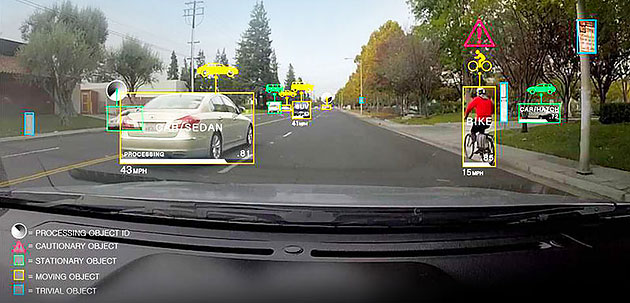Computer Vision’s Impact on the Automotive Industry
June 14, 2018
Computer vision, machine vision, or vision technology is an emerging tool that aims to provide expert-level accuracy in identifying objects or classifying them in less than a fraction of a second. This is done by replicating the sensorial systems in living creatures. A sensor captures a representation of the image, then a processing core analyzes it by comparing the input with an existing database. Once the system identifies a good enough match, it makes a decision.
This process performs numerous transformations on the image to make it look like something that it already knows. It can work with colors, brightness, angles or reflections.
The difficulty compared to the way our brain processes images and recognizes objects is that the machine does not actually see anything, it only gets an input of numbers representing brightness, distances, elevation and more. It’s almost like playing charades. By looking at descriptive data, it has to guess what the object might be.
The mind of the computer vision system consists of neural networks, which, through proper training, can learn to recognize various patterns as objects. However, until now the results have been far from perfect.
Automotive Applications
Computer Vision (CV) could make a real difference in the automotive industry by adding important safety features to our vehicles. If a car could stop before an accident happens, it could save countless lives and property.
CV is already being used in driver assistance systems to detect simple objects such as road lanes, traffic signs, and road boundaries. All autopilots include these functions, but are only usable in monotonous conditions, with little variation, such as highway traffic.
Using CV systems is not limited to self-driving cars, it can also be applied in the production process to identify parts at a glance.
Current Challenges and Possible Solutions
The failures of Google and Uber’s self-driving cars show there are still pending problems to solve before such vehicles can be mass produced.
Safety
The most significant concern with self-driving cars is related to the safety of passengers and other commuters and pedestrians. This includes the problem of stopping at a decent distance, making the right choice when entering an intersection or changing lanes.
A more delicate subject is related to data safety and cyber-security. Since the operation of such vehicles relies on algorithms, these should pass rigorous tests. All communication between sensors and the processing unit should be protected to avoid hijacking by hackers.
Unclear Lane Markings
Current road markings are designed for humans, not machines and the absence of markings in some areas is not problematic for drivers, but it could be fatal to autonomous cars. The solution to this problem could include remarking the road with computer-vision friendly signs, but that is a slow and costly process.
Detect Small or Insignificant Obstacles
Existing systems can see large objects, but for safe and comfortable driving, they should be able to avoid bumps in the road or potholes. Also, unexpected obstacles like fallen branches or roadkill could cause the system some problems and trigger errors.
The AI behind the system should be able to identify such situations and stop or slow down. This can only be achieved by training the algorithm with enough data from dashboard cams.
Stop at the Signal of the Police Officer
All drivers can identify when a police officer is pulling them over. Self-driving cars should be able to do the same. Although this is more difficult to implement through computer vision, there could be other solutions, like a radio/Wi-Fi communication system between law enforcement and the vehicle.
Identify Defective Traffic Lights
A human driver can immediately detect if the light signaling system on a road is not working at all or suspended (flickering yellow). A smart car powered by computer vision should be able to do the same and switch to guiding itself by the road signs.
Weather Independent
Computer vision sensors operate by measuring light variations to determine distances and angles. Some weather conditions could affect the accuracy of the reading by inflicting additional reflection or distortions. Rain or snow can act as temporary blocks of the systems and cause accidents.
Brooke, Sophia. (2018). “The impact of computer vision on the automotive industry”. Retrieved from https://channels.theinnovationenterprise.com/articles/the-impact-of-computer-vision-on-the-automotive-industry.
